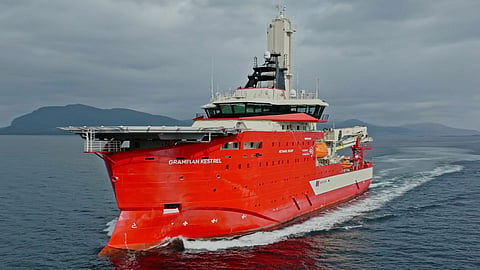VESSEL REVIEW | Grampian Kestrel – Hybrid CSOV built for North Sea wind farm support duties
UK operator North Star formally recently took delivery of a new commissioning service operation vessel (CSOV) built by Norway’s Vard.
Grampian Kestrel utilises a design that was developed by Vard Design specifically for and in collaboration with North Star. The bespoke vessel features an optimised hull form and a hybrid propulsion system that can be configured to run on methanol fuel in the future.
“The vessel represents a significant advancement in offshore marine technology, uniquely designed as [a] methanol-prepared hybrid ship that combine[s] battery energy storage and low-emission propulsion systems to reduce carbon output,” North Star told Baird Maritime. “They have received approval in principle for methanol use and carriage, reflecting compliance with strict safety and environmental standards.”
Custom-designed to high safety and operability standards
North Star said the design of Grampian Kestrel was developed through a rigorous technical evaluation against the highest standards within the offshore maritime industry. This ensured that the vessel exceeded expectations in terms of stability and station-keeping performance, which the company regards as critical for maximising operational uptime in demanding offshore environments.
“This process included comprehensive technical assessments of alternative fuel options, specifically evaluating pathways to reduce carbon emissions in alignment with the IMO decarbonisation targets. In addition, a detailed review was conducted on all major operational systems and equipment to ensure optimal reliability, efficiency, and maintainability throughout the vessel’s lifecycle.”
The CSOV measures 95 by 19.5 metres (310 by 64 feet) and has single cabin accommodation for up to 111 windfarm technicians as well as space for a daughtercraft. It was designed to be able to support all aspects of an offshore wind farm’s life cycle, offering accommodation, walk-to-work access and cargo handling to facilitate construction and commissioning works.
The vessel is also equipped with technology from Vard Electro’s portfolio, covering solutions for power, control, bridge and navigation, and communication. These include a bridge system for seamless vessel operation and control, drives, switchboards, and an energy storage system.
A control package features an integrated automation system, a power management system, and an energy management system. The communication package meanwhile covers CCTV, LAN/WLAN, telephone systems, and onboard TV/entertainment solutions for safety, connectivity, and crew comfort.
Vard Interiors supplied the complete interior outfitting, including HVAC-R systems and piping.
The vessel’s propulsion setup includes a Voith electric system that North Star said offers enhanced manoeuvrability, precision and reliability, making it ideal for CSOVs operating in support of the offshore wind sector.
“Its compact, gearbox-free design reduces maintenance and supports hybrid or alternative fuels,” said North Star. “With low noise emission and vibration, it enhances crew comfort, while its fast responsive thrust control is perfect for dynamic positioning and safe personnel transfers.”
The CSOV has a specialised deck equipment setup tailored for offshore wind commissioning and service operations. SMST provided a motion-compensated gangway with an integrated elevator system to enable seamless safe transfer to wind turbines. SMST also supplied the 3D motion-compensated crane to provide precise cargo handling in dynamic offshore conditions.
“MacGregor supplied a 16-tonne SWL single point davit launch and recover[y system for] the Chartwell [designed] daughtercraft, which is available on all our vessels and outperforms its design parameters,” said North Star. “The integrated deck layout is designed around redundancy so [as] to maintain flow and uptime while operating.”
For North Star, one of the most significant challenges was ensuring the vessel met the highest operational and environmental standards expected of elite offshore service vessels.
“This meant carefully integrating a wide range of stakeholder expectations—client requirements, regulatory compliance, future-proofing for alternative fuels, and achieving superior station-keeping and comfort standards,” the owner told Baird Maritime. “Balancing innovation with practicality, particularly in areas like fuel readiness, cyber resilience, and noise/vibration performance, required a thorough and forward-looking design approach.”
Enhanced cyber security features coupled with adaptability for future fuels
The company said the construction phase also presented multiple challenges, notably the integration of complex technologies such as hybrid propulsion systems, methanol preparedness, and smart automation.
“Ensuring these systems worked seamlessly together while complying with evolving international maritime regulations (IMO, IGC, IGF codes) added layers of complexity. Additionally, coordinating with shipyard partners and suppliers to maintain quality and delivery schedules, despite global supply chain pressures, was a major logistical and technical hurdle.”
The project offered North Star a number of insights. For the owner, one key area was gaining a deep understanding of methanol as an alternative fuel—its handling, safety protocols, and compliance requirements under emerging global standards.
“We also gained firsthand experience with the implementation of robust cyber security frameworks, which are becoming increasingly critical in vessel design.” said North Star. “Overall, the project strengthened [our] ability to manage technical risk, drive innovation, and align advanced engineering with real-world operational demands.”
Grampian Kestrel's initial deployment will be in support of German energy company EnBW at the latter's He Dreiht offshore wind farm in the North Sea, which will have a total installed output of 960 MW upon completion.
North Star said Grampian Kestrel and sister ship Grampian Eagle, which was also recently delivered, have achieved Lloyd’s Register’s highest comfort classification for noise and vibration, enhancing crew well-being, as well as its "cyber resilience" classification in line with mandatory IACS implemented for all newbuilds from July 1, 2024.


